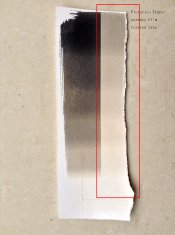duckie
Member
- Joined
- Jun 30, 2009
- Messages
- 8
- Format
- Large Format
The attached test strip was the one that I made for determining the basic exposure for palladium printing. I used a blank sheet of Pictorico Ultra Premium OHP Transparency Film to cover part of the coated area on Bergger COT-320. And It turned out that the area covered by the film would never reach the same density as the uncovered part, even if I had increased the exposure time up to 6 minutes. Its density was in gradual increase in brown, could not even reach dark brown, while the uncoverd part seemed to have reached its Dmax within 2 minutes.
And for coating the paper, the suggestions I found on the net are telling that 6 drops of Ferric Oxalate plus 6 drops of Palladium solution would be sufficient for a 4X5 -inch image. I didn't realize that it was not sufficient until it turned out to be. What's the common practice in this situation? Let it dry down and give a second coating?
Sorry for the naive questions as I'm all new to the process.
Thanks much in advance for any kind reply!
And for coating the paper, the suggestions I found on the net are telling that 6 drops of Ferric Oxalate plus 6 drops of Palladium solution would be sufficient for a 4X5 -inch image. I didn't realize that it was not sufficient until it turned out to be. What's the common practice in this situation? Let it dry down and give a second coating?
Sorry for the naive questions as I'm all new to the process.
Thanks much in advance for any kind reply!










